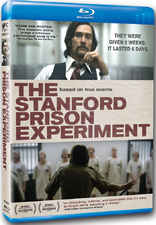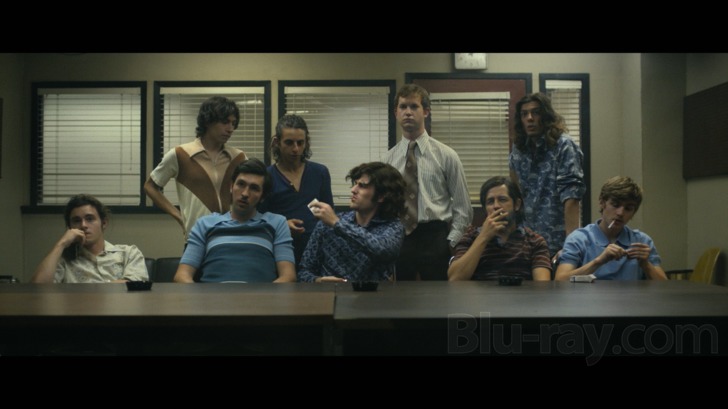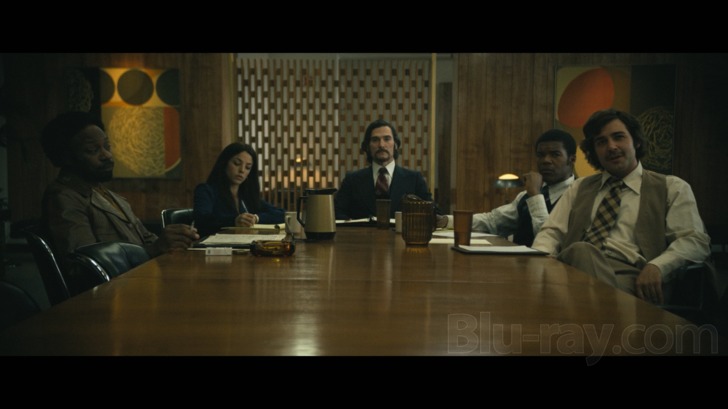The Stanford Prison Experiment Blu-ray Movie
HomeThe Stanford Prison Experiment Blu-ray Movie 
IFC Films | 2015 | 122 min | Rated R | Jan 12, 2016
Movie rating
7.1 | / 10 |
Blu-ray rating
| Users | 4.0 | |
| Reviewer | 4.0 | |
| Overall | 4.0 |
Overview
The Stanford Prison Experiment (2015)
Psychologist Philip Zimbardo simulates a prison in the basement of a Stanford building, with volunteer students divided into "guards" and "prisoners".
Starring: Olivia Thirlby, Ezra Miller, Thomas Mann (V), Billy Crudup, Callan McAuliffeDirector: Kyle Patrick Alvarez
| Biography | Uncertain |
| Thriller | Uncertain |
| Drama | Uncertain |
| History | Uncertain |
Specifications
Video
Video codec: MPEG-4 AVC
Video resolution: 1080p
Aspect ratio: 2.40:1
Original aspect ratio: 2.39:1
Audio
English: DTS-HD Master Audio 5.1 (48kHz, 24-bit)
English: LPCM 2.0 (48kHz, 24-bit)
Subtitles
English SDH, Spanish
Discs
50GB Blu-ray Disc
Single disc (1 BD)
Playback
Region A (C untested)
Review
Rating summary
| Movie | 4.0 | |
| Video | 4.0 | |
| Audio | 4.0 | |
| Extras | 3.5 | |
| Overall | 4.0 |
The Stanford Prison Experiment Blu-ray Movie Review
Fake Prison, Real Abuse
Reviewed by Michael Reuben January 14, 2016Barely a decade after social psychologist Stanley Milgram astonished the world with his
"obedience experiment" at Yale, another psychologist,
Philip Zimbardo, created an equally
notorious phenomenon at Stanford with his "prison experiment". Funded by the U.S. Navy, Dr.
Zimbardo recruited student volunteers to simulate a prison environment in an effort to
understand the roots of conflict between prisoners and guards. The simulation spun out of control
so rapidly that the two-week experiment had to be shut down after only six days. Zimbardo
subsequently scripted a documentary, Quiet Rage, and published a book,
The Lucifer Effect, about the experiment and his subsequent work.
Zimbardo's "Stanford Prison Experiment" has penetrated popular culture just as deeply as
Milgram's work on obedience. Author Mario Giordano used it as inspiration for his novel The
Black Box, which was adapted into a German film called Das
Experiment (2001) and an English-language remake, The Experiment (2010). Various TV shows have modeled plots on Zimbardo's
simulation, the most recent example being the "PhDead" episode of ABC's Castle
(October 5,
2015).
As its title suggests, The Stanford Prison Experiment (or "SPE") dramatizes the actual events of
Zimbardo's experiment instead of a fictional alternative. Producer Brent Emery commissioned
the script from Tim Talbott (a former writer for South Park) in 2002,
after which the project
entered a long period of development and delay. Throughout the process, however, the core
principle was that the actual events of Zimbardo's experiment needed no embellishment to make
a compelling film. The challenge was to assemble a large cast of sufficient talent to bring the
experience to life, then find a way to stage the action cinematically in a confined space. The
assignment eventually fell to director Kevin Patrick Alvarez (C.O.G.).
SPE premiered at the Sundance Film Festival in January 2015, where it received the Waldo Salt
Screenwriting Award for Talbott's script and the Alfred P. Sloan Feature Film Prize for
Alvarez's direction. IFC Films released the film in theaters the following July. The Blu-ray first
appeared as a Best Buy exclusive on November 15 and is now available in general release.

SPE plunges directly into the experiment, as a team of graduate students working for Dr. Zimbardo (Billy Crudup) interview and select prospective participants, who are randomly assigned the role of "prisoner" or "guard". Mock "cells" and other prison fixtures are established in a basement hallway of Stanford's Jordan Hall. The "guards" are issued uniforms and mirrored sunglasses and instructed to enforce a strict set of rules, while the "prisoners" are dressed in smocks resembling dresses, are identified only by numbers and are required to address each guard as "Mr. Correctional Officer". To help set the tone, Zimbardo enlists the local police force to "arrest" each "prisoner" and bring him blindfolded to the mock prison for processing. The "guards" are prohibited from using physical force, but there are neither limits nor guidelines on the forms of intimidation and psychological abuse that may be employed.
Initially the process is almost comical, as three "guards" fumble through an intake checklist, while Prisoner 8612 (Ezra Miller) looks alternately amused and bewildered. But the tone shifts abruptly with the arrival of a "guard" named Christopher Welch (Michael Angarano), who, as he later explains in a debriefing, has decided to see just how far he can push the "prisoners" before they protest. Assuming the voice and manner of Strother Martin's ruthless Captain in Cool Hand Luke, Welch immediately begins needling and mocking the "prisoners', inspiring other "guards" to compete with him in cruelty. (Incongruously, he is dubbed "John Wayne" by his fellow participants.) Prisoner 8612 becomes a special target of abuse, for reasons about which the observers disagree. Is he the most vulnerable of the group, or potentially the most "dangerous"? He's certainly the first "prisoner" to urge others to revolt, since they outnumber the "guards".
Zimbardo and his team observe these developments on closed-circuit cameras, with a combination of fascination and delight at the behavior their simulation has elicited. Caught up in the enthusiasm of success, they allow the "guards'" behavior to escalate unchecked. Sleep deprivation, extended time in "the hole" (a converted closet), endless calisthenics and room inspections, threats of physical force and one actual blow from a nightstick, and a variety of humiliations and harassment become the norm. Within days, an escape has been attempted (and foiled), and a prisoner "revolt" has been triggered and put down. By the end, the "guards" have progressed to forms of degradation that stop just short of sexual assault.
A stubborn (and probably) unanswerable question underlying SPE is exactly what the participants' behavior reveals about real prisons, if anything at all. As various characters note, these are nothing more than college boys acting tough. The unreality of the situation sparks a protest from Jesse Fletcher (True Blood's Nelsan Ellis), a former San Quentin inmate whom Zimbardo has recruited as a consultant. But even Fletcher cannot resist the seduction of role-playing, as he discovers at a mock "parole" hearing, where he convincingly bullies and grills a parole "applicant" in exactly the same manner that he experienced while serving his own sentence.
Perhaps the worst case of self-deception is Zimbardo himself. As the psychologist witnesses the deteriorating situation, he repeatedly refuses to intervene, even when his own grad students urge him to do so. Instead, he turns up the pressure by bringing in a priest (Albert Malafronte) to "counsel" the prisoners, all the while pretending that this is no longer a simulation. Just as the line blurs between role-playing and reality for the students, Zimbardo's role as prison "superintendent" begins to possess him. When talking to the "guards", he refers to the mock facility as "my prison", but soon he is using the same expression when talking to other psychologists. It takes his girlfriend and former student, Dr. Christina Maslach (Olivia Thirlby), to recognize that Zimbardo has succumbed to the experiment's allure and is no longer an objective observer.
Alvarez, who edited the film in addition to directing it, takes full advantage of the mock prison's claustrophobic quarters to give SPE a tightening discomfort, gradually narrowing his shots as the war of nerves between "prisoners' and "guards" escalates. He repeatedly cuts to closeups of onlookers, using the facial expressions of "guards", "prisoners" and simulation staff to comment on the action. Some "guards" are clearly troubled by the behavior of their colleagues; some "prisoners" object to how they're treated but are too intimidated to speak up; and some members of the staff think their boss may be losing it. Zimbardo's academic critics have argued that his experiment was too flawed a simulation to reveal anything meaningful about real prison life, but SPE does not address that issue, even in the concluding clips where participants reflect on their experience. The film simply shows in harrowing detail how a "pretend" conflict became so real that it had to be stopped before someone got hurt.
The Stanford Prison Experiment Blu-ray Movie, Video Quality 

The Stanford Prison Experiment was shot on the Red Dragon by cinematographer Jas Shelton
(Jeff, Who Lives at Home). Post-production
was completed on a digital intermediate, where the
flat and largely monochromatic image was gradually darkened and "roughened" to create a visual
evolution that matched the story's dramatic arc. MPI/IFC's 1080p, AVC-encoded Blu-ray was
presumably sourced directly from digital files.
The simulated prison scenes have a flat, dull look that, together with the limited color palette,
emphasizes the "prisoners'" sense of being dumped into limbo. Whenever the action steps
outside these corridors, the color palette is immediately richer and more varied, and the
perception of depth is enhanced through the use of shadow and darkness. (Probably not by
accident, Zimbardo is frequently shown in rooms with limited light.) The Blu-ray captures both
visual styles in a sharp image with good reproduction of fine detail, the better to appreciate the
Seventies costumes and hairstyles and the increasingly haggard features of the simulation
participants. SPE is not a pretty film, but its cinematography serves its subject matter.
MPI/IFC has mastered SPE with an average bitrate of 35 Mbps, which would be a good rate for a
project originated on film. For a digitally originated project, it is more than sufficient.
The Stanford Prison Experiment Blu-ray Movie, Audio Quality 

SPE's 5.1 soundtrack, encoded in lossless DTS-HD MA, is a precise affair, where specific sound
effects (e.g., a "guard's" baton smacking a table, a fire extinguisher being triggered, or a prisoner
pounding on a wall) are loud and clear, cutting through the hermetic isolation of the simulated
prison and sharply contrasting with the continuing elements of dialogue and environmental
ambiance. The sound mixers have taken care to keep the many different voices distinct and
intelligible, even when it isn't necessarily clear which "prisoner" or "guard" is speaking.
(Michael Angarano's "John Wayne" can be easily recognized by his Strother Martin impression,
but the rest of the "prisoners" and "guards" tend to blend together interchangeably.) Andrew
Hewitt (The Double) has supplied a spare but
effective electronic score.
As is routinely the case with MPI's Blu-rays, an alternate PCM 2.0 track is also included.
The Stanford Prison Experiment Blu-ray Movie, Special Features and Extras 

- Commentary with Director Kevin Patrick Alvarez: Taking his cue from DVD commentaries that he found useful when he was studying film, Alvarez focuses on the mechanics of filmmaking. His presentation is impressively detailed. He describes visual strategies, breaks down individual scenes, points out places where he had to compromise because of insufficient time, and explains his editing choices. He even discusses the technical challenge of establishing proper "eyelines". The commentary is a valuable resource, and it would be even more useful if the Blu-ray included the many deleted scenes to which Alvarez refers.
- Bringing to Life the Stanford Prison Experiment (1080p; 1.78:1; 9:38): This is a reasonably informative EPK featuring Alvarez and the principal cast.
- The Psychology Behind the Stanford Prison Experiment (1080p; 1.78:1; 2:47): This brief featurette could have been incorporated into the longer "Bringing to Life" entry listed above. The real Philip Zimbardo is included among the interviewees.
- Trailer (1080p; 2.35:1; 2:33).
- Additional Trailers: At startup, the disc plays trailers for Welcome to New York, Match , Jenny's Wedding and Time Out of Mind, which can be skipped with the chapter forward button and are not otherwise available once the disc loads.
The Stanford Prison Experiment Blu-ray Movie, Overall Score and Recommendation 

The duality of cop and criminal is an established theme in crime dramas. (As Jack Nicholson's
mob boss observes in The Departed, "When I was your
age
they would say we can become cops,
or criminals. . . . When you're facing a loaded gun, what's the difference?") The same theme
informs SPE, where, as Billy Crudup's Zimbardo points out, the only thing that separates the
"guards" who became abusive from the prisoners being abused was a coin flip. Would the
simulation have played out differently if the coin flips were reversed? No one can say for sure,
but Zimbardo's experiment, like Milgrim's, demonstrated how easily a person's behavior can be
altered by an institutional structure, even a pretend one. In the debriefing tapes, a former "guard"
protests that he's a nice guy who was simply playing a part, to which one of the "prisoners"
replies that he still hates him, "[b]ecause I know what you can become." Provocative and highly
recommended.
Similar titles
Similar titles you might also like

In the Name of the Father
1993

Rosewater
2014

The Mauritanian
2021

Mandela: Long Walk to Freedom
2013

Conviction
2010

Papillon
2017

Midnight Express
1978

Experimenter
2015

Professor Marston and the Wonder Women
2017

The 15:17 to Paris
2018

House of Gucci 4K
2021

Talk to Me
2007

Operation Finale
2018

W.
2008

A Mighty Heart
2007

Hunger
2008

Boy Erased
2018

Goya's Ghosts
2006

Escape from Alcatraz 4K
1979

Fruitvale Station
2013